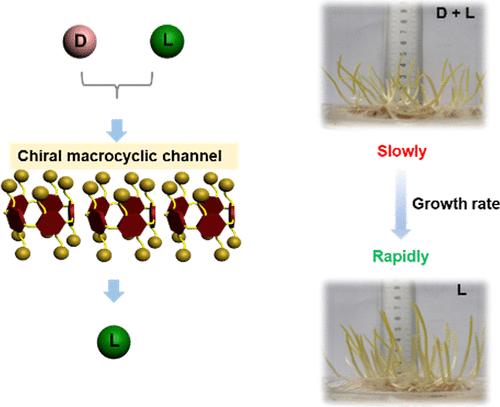含有亚纳米通道的手性膜对映选择性转运氨基酸
IF 6.7
1区 化学
Q1 CHEMISTRY, ANALYTICAL
引用次数: 0
摘要
手性分离技术的研究对于认识生命起源和促进手性分子的应用具有重要意义。本文设计合成了阴离子型手性柱[6]芳烃和阳离子型手性柱[6]芳烃,并通过静电相互作用逐层组装成手性柱[6]芳烃膜。l-Ala和d-Ala在该通道中的传输速率分别为14.33 μM cm-2 h-1和1.86 μM cm-2 h-1,其中l-Ala的传输速率是d-Ala的7.7倍。在Ala消旋体输运实验中,单次分离后渗透液中l-Ala的ee值为62%,说明该通道具有一定的手性分离能力。进一步研究了组装方式、手性层数和驱动力对分离效果的影响,并通过分子水平的主客体相互作用和理论模拟探索了选择性输运机制。该策略为拓展手性柱[n]芳烃在膜分离领域的应用提供了新的模板。本文章由计算机程序翻译,如有差异,请以英文原文为准。

Chiral Membrane Containing Subnanometer Channels for Enantioselective Transport Amino Acids
The research of chiral separation technology is of great significance for understanding the origin of life and promoting the application of chiral molecules. Herein, anionic chiral pillar[6]arene and cationic pillar[6]arene were designed and synthesized, and a chiral pillar[6]arene membrane was constructed by layer-by-layer assembly through electrostatic interactions. The transport rates of l-Ala and d-Ala in this channel were 14.33 and 1.86 μM cm–2 h–1, respectively, and the transport rate of l-Ala was 7.7 times that of d-Ala. In the transport experiment of Ala racemate, the ee value of l-Ala in the permeate after a single separation was 62%, indicating that this channel has a certain chiral separation ability. The effects of the assembly method, the number of chiral layers, and the driving force on the separation effect were further studied, and the selective transport mechanism was explored through the host–guest interaction at the molecular level and theoretical simulation. This strategy provides a new template for expanding the application of chiral pillar[n]arenes in the field of membrane separation.
求助全文
通过发布文献求助,成功后即可免费获取论文全文。
去求助
来源期刊

Analytical Chemistry
化学-分析化学
CiteScore
12.10
自引率
12.20%
发文量
1949
审稿时长
1.4 months
期刊介绍:
Analytical Chemistry, a peer-reviewed research journal, focuses on disseminating new and original knowledge across all branches of analytical chemistry. Fundamental articles may explore general principles of chemical measurement science and need not directly address existing or potential analytical methodology. They can be entirely theoretical or report experimental results. Contributions may cover various phases of analytical operations, including sampling, bioanalysis, electrochemistry, mass spectrometry, microscale and nanoscale systems, environmental analysis, separations, spectroscopy, chemical reactions and selectivity, instrumentation, imaging, surface analysis, and data processing. Papers discussing known analytical methods should present a significant, original application of the method, a notable improvement, or results on an important analyte.
 求助内容:
求助内容: 应助结果提醒方式:
应助结果提醒方式:


